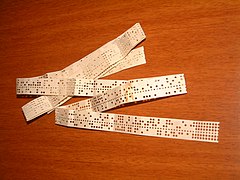Baudot code
The Baudot code, named after its inventor Émile Baudot, is a predecessor character set to EBCDIC and ASCII and was originally used primarily in teletypes.
History
| ||||||||||||||||||||||||||||||||||||||||||||||||||||||||||||||||||||||||||||||||||||||||||||||||||||||||||||||||||||||||||||||||||||||||||||||||||||||||||||||||||||||||||||||||||||||||||||||||||||||||||||||||||||||||||||||||||||||||||||||||||||||||||
Baudot's original code, developed around 1874, is known as International Telegraph Alphabet No. 1, and is no longer in use today. For its transmission, a five-key keyboard was used where each key represented a bit of the five-state signal. A mechanical wiper scanned the state of the keyboard and released the keys allowing the operator to enter the next character.
In 1901 the Baudot code was modified by Donald Murray rearranging the characters, adding new ones as well as control codes. Murray's rearrangement was prompted by his development of a typewriter-like keyboard. So the arrangement of the bits was decoupled from the operator keys. Murray arranged his code so that the most used characters produced the fewest state changes, which minimized wear and tear on the equipment.
Another modification of the Murray code was adopted by the Western Union Company, and consisted of the discarding of some characters. This modification became known as the WRU ("Who aRe yo") code. The CCITT later introduced the International Telegraphy Alphabet No. 2 (ITA2) as an international standard; this was based on the Western Union Company code with minimal changes. The ITA2 is still used in telephones for the deaf, in radio amateurs, and in RTTY (radio teletypewriter).
CCITT-1 encoding
With a five-key keyboard, you can only define a number of words of 32 (= 25) different combinations and this number does not satisfy the 26 letters plus the 10 figures, therefore it does not can encode an alphabet. Baudot's idea was to introduce the idea of space as a command introducer, thus doubling the number of possibilities.
Contenido relacionado
Template:In development
Coding
MetaWiki
